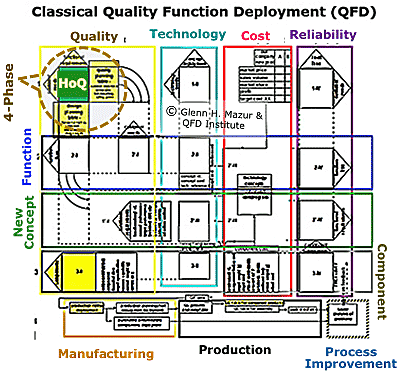Comprehensive QFD
Comprehensive QFD is a complex but very powerful product and process development method. It addresses not only the design and quality of the new product being developed, but also the company's product development process as well as business operation, bringing about a competitive focus to all activities in the company.
"Little did we appreciate at the start, that Comprehensive QFD would allow us to evaluate the functional, performance, reliability, and cost parameters of our products." — A tech company that received the QFD Black Belt® training
Dr. Akao, co-founder of the QFD method, introduced the full Comprehensive QFD model in his 1990 book "Quality Function Deployment: Integrating Customer Requirements into Product Design." This has been expanded with additional case studies and guidance in ISO 16355-5:2017 and ISO/TR 16355-8:2017.
It is also the foundation of the QFD Black Belt® training classes. Recently, an inquiry from the construction industry raised this question:
"Which deployments should be used in which circumstances, in particular Reliability Deployment, Safety Deployment, and Security Deployment?"
In response to this, the following should be considered.
ISO 16355 is a "descriptive" standard rather than a "prescriptive standard." That means it describes what QFD is and how to do it, but does not specify which deployments or tools are needed. It was written this way for a reason:
The purpose of QFD is to assure the quality of new products (this is the Q);
It means that all necessary internal departments perform their functions in such a way that quality is understood and becomes the focus of their departmental activity (this is the F); and;
It means that all these activities must be aligned to customer so that all focus on the same priorities (this is the D).
Therefore, there is no "right way" to do QFD. It depends on the management structure, the technology, the customers and their applications, the competition, and other factors.
When Dr. Akao began developing Comprehensive QFD in the 1980s, he began to realize that "quality" had different meanings to different people. Customers described quality as benefits to their work and life. R&D described quality as performance and functional characteristics of the product, and different technologies that could deliver these performance and functions. Engineering described quality as fit and finish, and that the product continues to function throughout its expected life. Manufacturing described quality as processes to build and assemble the product, and so on...
Thus, each of these types of quality became a "deployment" in Comprehensive QFD, so that charts and tables did not get too large or complex, and that different information sets could be organized according to its type. Proper organization of QFD information sets is essential for QFD to deliver meaningful results. Tools that help this organization are the Customer Voice table, Affinity diagram, Hierarchy diagram, Maximum Value table, and several matrices.
Reliability Deployment
Reliability Deployment is used to assure the reliability and durability of a new product. This means it functions consistently throughout its expected or advertised life. Reasons to do reliability deployment include having a history of product failures that must not be repeated, introducing a new technology which has known failure risks or unknown risks, outsourcing engineering or components to a new supplier or a supplier with a troublesome history, or trying to enter a market with new applications that have performance requirements beyond the current specifications, and are at risk of failure in extreme situations.
For construction, reliability deployment might consider dimensional shrinkage in pre-fabricated concrete slabs due to environmental, manufacturing, labor skill, or material conditions at a worksite. It would prioritize the impact of cracks, surface finish defects, dimensional variance, etc. It could help prioritize the impact of water penetration on loose or falling concrete, proliferation of mold, appearance, etc.
Reliability Deployment also includes Failure Mode and Effects Analysis (FMEA). The ISO 16355-5:2017 standard details how to do this with proper ratio-scale math instead of the ordinal-scale math found in most textbooks.
Safety Deployment
Safety Deployment is used to assure that new products are safe to manufacture, safe to transport, safe to use, and safe to dispose. Reasons to do safety deployment is when new technologies are introduced that might pose safety risks, when the operating environment might pose extreme but anticipated conditions, or when new markets, applications, or operators that do not have a culture of safety are entered.
For construction, safety deployment might consider impacts of earthquakes, wind storms, flooding, rising water tables or coastlines, penetration of use spaces by creatures that have migrated due to climate change, materials corrosion due to air pollution, etc. This might result in HVAC redundancy, changes to foundation design, changes to lighting, job safety for construction workers using new materials, methods, or equipment, etc.
Security Deployment
Security Deployment is used to assure that information regarding the product or users is not able to be hacked, stolen, or misused in any way. This deployment is growing in use as more physical and service products incorporate software and data in their design. Reasons to do security deployment would be to assure that company or customer information is password and firewall protected, data fields related to identification, payment, physical address or location, etc. are kept isolated, identity theft or account hijacking is prevented, etc.
For construction, security deployment might consider impacts of access codes to critical building systems, access codes and logs to non-public areas are secured, construction materials are secured to prevent theft or damage by the elements, etc.
Dr. Akao also included in Comprehensive QFD deployments for new technology, cost, weight, project management, and others.
Resources for all the deployments in Comprehensive QFD are:
Akao, Yoji ed. (1990) "Quality Function Deployment: Integrating Customer Requirements into Product Design"
For questions, please contact us.

